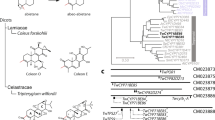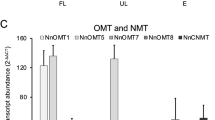Abstract
The gateway to morphine biosynthesis in opium poppy (Papaver somniferum) is the stereochemical inversion of (S)-reticuline since the enzyme yielding the first committed intermediate salutaridine is specific for (R)-reticuline. A fusion between a cytochrome P450 (CYP) and an aldo-keto reductase (AKR) catalyzes the S-to-R epimerization of reticuline via 1,2-dehydroreticuline. The reticuline epimerase (REPI) fusion was detected in opium poppy and in Papaver bracteatum, which accumulates thebaine. In contrast, orthologs encoding independent CYP and AKR enzymes catalyzing the respective synthesis and reduction of 1,2-dehydroreticuline were isolated from Papaver rhoeas, which does not accumulate morphinan alkaloids. An ancestral relationship between these enzymes is supported by a conservation of introns in the gene fusions and independent orthologs. Suppression of REPI transcripts using virus-induced gene silencing in opium poppy reduced levels of (R)-reticuline and morphinan alkaloids and increased the overall abundance of (S)-reticuline and its O-methylated derivatives. Discovery of REPI completes the isolation of genes responsible for known steps of morphine biosynthesis.
This is a preview of subscription content, access via your institution
Access options
Subscribe to this journal
Receive 12 print issues and online access
$259.00 per year
only $21.58 per issue
Buy this article
- Purchase on Springer Link
- Instant access to full article PDF
Prices may be subject to local taxes which are calculated during checkout




Similar content being viewed by others
References
Quasdorf, K.W. & Overman, L.E. Catalytic enantioselective synthesis of quaternary carbon stereocentres. Nature 516, 181–191 (2014).
Hagel, J.M. & Facchini, P.J. Benzylisoquinoline alkaloid metabolism: a century of discovery and a brave new world. Plant Cell Physiol. 54, 647–672 (2013).
Gulland, J.M. & Robinson, R. Constitution of codeine and thebaine. Mem. Proc. Manchester Lit. Phil. Soc. 69, 79–86 (1925).
Kirby, G.W. Biosynthesis of the morphine alkaloids. Science 155, 170–173 (1967).
Battersby, A.R., Foulkes, D.M. & Binks, R. Biosynthesis of morphine alkaloids. J. Chem. Soc. 33, 3323–3332 (1965).
Hirata, K., Poeaknapo, C., Schmidt, J. & Zenk, M.H. 1,2-Dehydroreticuline synthase, the branch point enzyme opening the morphinan biosynthetic pathway. Phytochemistry 65, 1039–1046 (2004).
De-Eknamkul, W. & Zenk, M.H. Purification and properties of 1,2-dehydroreticuline reductase from Papaver somniferum seedlings. Phytochemistry 31, 813–821 (1992).
Allen, R.S. et al. RNAi-mediated replacement of morphine with the nonnarcotic alkaloid reticuline in opium poppy. Nat. Biotechnol. 22, 1559–1566 (2004).
Facchini, P.J. & St-Pierre, B. Synthesis and trafficking of alkaloid biosynthetic enzymes. Curr. Opin. Plant Biol. 8, 657–666 (2005).
Jirschitzka, J. et al. Plant tropane alkaloid biosynthesis evolved independently in the Solanaceae and Erythroxylaceae. Proc. Natl. Acad. Sci. USA 109, 10304–10309 (2012).
Ballance, G.M. & Dixon, R.A. Medicago sativa cDNAs encoding chalcone reductase. Plant Physiol. 107, 1027–1028 (1995).
Desgagné-Penix, I., Farrow, S.C., Cram, D., Nowak, J. & Facchini, P.J. Integration of deep transcript and targeted metabolite profiles for eight cultivars of opium poppy. Plant Mol. Biol. 79, 295–313 (2012).
Amann, M. & Zenk, M.H. Preparation of dehydrobenzylisoquinolines by immobilized (S)-tetrahydroprotoberberine oxidase from plant cell cultures. Phytochemistry 26, 3235–3240 (1987).
Amann, M., Nagakura, N. & Zenk, M.H. Purification and properties of (S)-tetrahydroprotoberberine oxidase from suspension-cultured cells of Berberis wilsoniae. Eur. J. Biochem. 175, 17–25 (1988).
Takemura, T., Ikezawa, N., Iwasa, K. & Sato, T. Molecular cloning and characterization of a cytochrome P450 in sanguinarine biosynthesis from Eschscholzia californica cells. Phytochemistry 91, 100–108 (2013).
Beaudoin, G.A.W. & Facchini, P.J. Isolation and characterization of a cDNA encoding (S)-cis-N-methylstylopine 14-hydroxylase from opium poppy, a key enzyme in sanguinarine biosynthesis. Biochem. Biophys. Res. Commun. 431, 597–603 (2013).
Dang, T.T.T. & Facchini, P.J. CYP82Y1 is N-methylcanadine 1-hydroxylase, a key noscapine biosynthetic enzyme in opium poppy. J. Biol. Chem. 289, 2013–2026 (2014).
Dang, T.T.T., Chen, X. & Facchini, P.J. Acetylation serves as a protective functional group in noscapine biosynthesis in opium poppy. Nat. Chem. Biol. 11, 104–106 (2015).
Morikawa, T. et al. Cytochrome P450 CYP710A encodes the sterol C-22 desaturase in Arabidopsis and tomato. Plant Cell 18, 1008–1022 (2006).
Field, B. & Osbourn, A.E. Metabolic diversification—independent assembly of operon-like gene clusters in different plants. Science 320, 543–547 (2008).
Martens, S. & Mithöfer, A. Flavones and flavone synthases. Phytochemistry 66, 2399–2407 (2005).
Mizutani, M. & Sato, F. Unusual P450 reactions in plant secondary metabolism. Arch. Biochem. Biophys. 507, 194–203 (2011).
Akashi, T. et al. Molecular cloning and biochemical characterization of a novel cytochrome P450, flavone synthase II, that catalyzes direct conversion of flavanones to flavones. Plant Cell Physiol. 40, 1182–1186 (1999).
He, X.S. 1,2-Dehydroreticuline: conversion of iminium salts into enamimes. J. Nat. Prod. 56, 973–975 (1993).
Battersby, A.R., Foulkes, D.M., Hirst, M., Parry, G.V. & Staunton, J. Alkaloid biosynthesis. Part XI. Studies related to the formation and oxidation of reticuline in morphine biosynthesis. J. Chem. Soc. C 1968, 210–216 (1968).
Penning, T.M. The aldo-keto reductases (AKRs): overview. Chem. Biol. Interact. 234, 236–246 (2015).
Wang, Y., Yi, H., Wang, M., Yu, O. & Jez, J.M. Structural and kinetic analysis of the unnatural fusion protein 4-coumaroyl-CoA ligase:stilbene synthase. J. Am. Chem. Soc. 133, 20684–20687 (2011).
Brodelius, M., Lundgren, A., Mercke, P. & Brodelius, P.E. Fusion of farnesyldiphosphate synthase and epi-aristolochene synthase, a sesquiterpene cyclase involved in capsidiol biosynthesis in Nicotiana tabacum. Eur. J. Biochem. 269, 3570–3577 (2002).
Sharma, H., Landau, M.J., Vargo, M.A., Spasov, K.A. & Anderson, K.S. First three-dimensional structure of Toxoplasma gondii thymidylate synthase-dihydrofolate reductase: insights for catalysis, interdomain interactions, and substrate channeling. Biochemistry 52, 7305–7317 (2013).
Peters, R.J., Carter, O.A., Zhang, Y., Matthews, B.W. & Croteau, R.B. Bifunctional abietadiene synthase: mutual structural dependence of the active sites for protonation-initiated and ionization-initiated cyclizations. Biochemistry 42, 2700–2707 (2003).
Elleuche, S. Bringing functions together with fusion enzymes—from nature's inventions to biotechnological applications. Appl. Microbiol. Biotechnol. 99, 1545–1556 (2015).
Marienhagen, J. & Bott, M. Metabolic engineering of microorganisms for the synthesis of plant natural products. J. Biotechnol. 163, 166–178 (2013).
Pillai, B. et al. Structural insights into stereochemical inversion by diaminopimelate epimerase: an antimicrobial drug target. Proc. Natl. Acad. Sci. USA 103, 8668–8673 (2006).
Morrison, J.P., Read, J.A., Coleman, W.G. & Tanner, M.E. Dismutase activity of ADP-L-glycero-D-manno-heptose 6-epimerase: evidence for a direct oxidation/reduction mechanism. Biochemistry 44, 5907–5915 (2005).
Marbaix, A.Y. et al. Extremely conserved ATP- or ADP-dependent enzymatic system for nicotinamide nucleotide repair. J. Biol. Chem. 286, 41246–41252 (2011).
Stapon, A., Li, R. & Townsend, C.A. Synthesis of (3S,5R)-carbapenam-3-carboxylic acid and its role in carbapenem biosynthesis and the stereoinversion problem. J. Am. Chem. Soc. 125, 15746–15747 (2003).
Suhre, K. Inference of gene function based on gene fusion events: the rosetta-stone method. Methods Mol. Biol. 396, 31–41 (2007).
Nützmann, H.-W. & Osbourn, A. Gene clustering in plant specialized metabolism. Curr. Opin. Biotechnol. 26, 91–99 (2014).
Winzer, T. et al. A Papaver somniferum 10-gene cluster for synthesis of the anticancer alkaloid noscapine. Science 336, 1704–1708 (2012).
Schiff, P.L. Bisbenzylisoquinoline alkaloids. J. Nat. Prod. 60, 934–953 (1997).
Matasci, N. et al. Data access for the 1,000 Plants (1KP) project. Gigascience 3, 17 (2014).
Morishige, T., Tsujita, T., Yamada, Y. & Sato, F. Molecular characterization of the S-adenosyl-L-methionine:3′-hydroxy-N-methylcoclaurine 4′-O-methyltransferase involved in isoquinoline alkaloid biosynthesis in Coptis japonica. J. Biol. Chem. 275, 23398–23405 (2000).
Choi, K.B., Morishige, T., Shitan, N., Yazaki, K. & Sato, F. Molecular cloning and characterization of coclaurine N-methyltransferase from cultured cells of Coptis japonica. J. Biol. Chem. 277, 830–835 (2002).
Ro, D.K. et al. Production of the antimalarial drug precursor artemisinic acid in engineered yeast. Nature 440, 940–943 (2006).
Pompon, D., Louerat, B., Bronine, A. & Urban, P. Yeast expression of animal and plant P450s in optimized redox environments. Methods Enzymol. 272, 51–64 (1996).
Dang, T.T.T. & Facchini, P.J. Cloning and characterization of canadine synthase involved in noscapine biosynthesis in opium poppy. FEBS Lett. 588, 198–204 (2014).
Liu, Y., Schiff, M. & Dinesh-Kumar, S.P. Virus-induced gene silencing in tomato. Plant J. 31, 777–786 (2002).
Dinesh-Kumar, S.P., Anandalakshmi, R., Marathe, R., Schiff, M. & Liu, Y. Virus-induced gene silencing. Methods Mol. Biol. 236, 287–294 (2003).
Desgagné-Penix, I. & Facchini, P.J. Systematic silencing of benzylisoquinoline alkaloid biosynthetic genes reveals the major route to papaverine in opium poppy. Plant J. 72, 331–344 (2012).
Farrow, S.C. & Facchini, P.J. Dioxygenases catalyze O-demethylation and O,O-demethylenation with widespread roles in benzylisoquinoline alkaloid metabolism in opium poppy. J. Biol. Chem. 288, 28997–29012 (2013).
Thompson, J.D., Gibson, T.J., Plewniak, F., Jeanmougin, F. & Higgins, D.G. The CLUSTAL_X windows interface: flexible strategies for multiple sequence alignment aided by quality analysis tools. Nucleic Acids Res. 25, 4876–4882 (1997).
Acknowledgements
We thank D. Nelson (University of Tennessee) for assigning the CYP nomenclature. This work was supported by grants from Genome Canada, Genome Alberta, the Government of Alberta, the Canada Foundation for Innovation and the Natural Sciences and Engineering Research Council of Canada to P.J.F. S.C.F. and G.A.W.B. were recipients of scholarships from the Natural Sciences and Engineering Research Council of Canada. S.C.F. also received a scholarship from Alberta Innovates Technology Futures.
Author information
Authors and Affiliations
Contributions
S.C.F. performed all recombinant enzyme assays, virus-induced gene silencing experiments and mass spectrometric analyses, and co-wrote the manuscript. J.M.H. constructed the yeast expression vectors, performed all qRT-PCR experiments, and co-wrote the manuscript. D.C.B. conducted and interpreted the NMR analysis. G.A.W.B. contributed to the initial gene isolations. P.J.F. directed the research, prepared the figures and tables, and edited the manuscript.
Corresponding author
Ethics declarations
Competing interests
P.J.F., S.C.F. and G.A.W.B. have filed a patent application (Patent Cooperation Treaty Application PCT/CA2014/0511164) covering compositions and methods related to the manufacture or (R)-reticuline and precursors thereof.
Supplementary information
Supplementary Text and Figures
Supplementary Results, Supplementary Figures 1–16 and Supplementary Tables 1–6. (PDF 12100 kb)
Rights and permissions
About this article
Cite this article
Farrow, S., Hagel, J., Beaudoin, G. et al. Stereochemical inversion of (S)-reticuline by a cytochrome P450 fusion in opium poppy. Nat Chem Biol 11, 728–732 (2015). https://doi.org/10.1038/nchembio.1879
Received:
Accepted:
Published:
Issue Date:
DOI: https://doi.org/10.1038/nchembio.1879
This article is cited by
-
Regulation of T16H subcellular localization for promoting its catalytic efficiency in yeast cells
Biotechnology Letters (2024)
-
Elucidation of the (R)-enantiospecific benzylisoquinoline alkaloid biosynthetic pathways in sacred lotus (Nelumbo nucifera)
Scientific Reports (2023)
-
Emerging functions within the enzyme families of plant alkaloid biosynthesis
Phytochemistry Reviews (2023)
-
Biotechnological Approaches for Enhancing Polyhydroxyalkanoates (PHAs) Production: Current and Future Perspectives
Current Microbiology (2023)
-
Plant cytochrome P450s directing monoterpene indole alkaloid (MIA) and benzylisoquinoline alkaloid (BIA) biosynthesis
Phytochemistry Reviews (2023)



